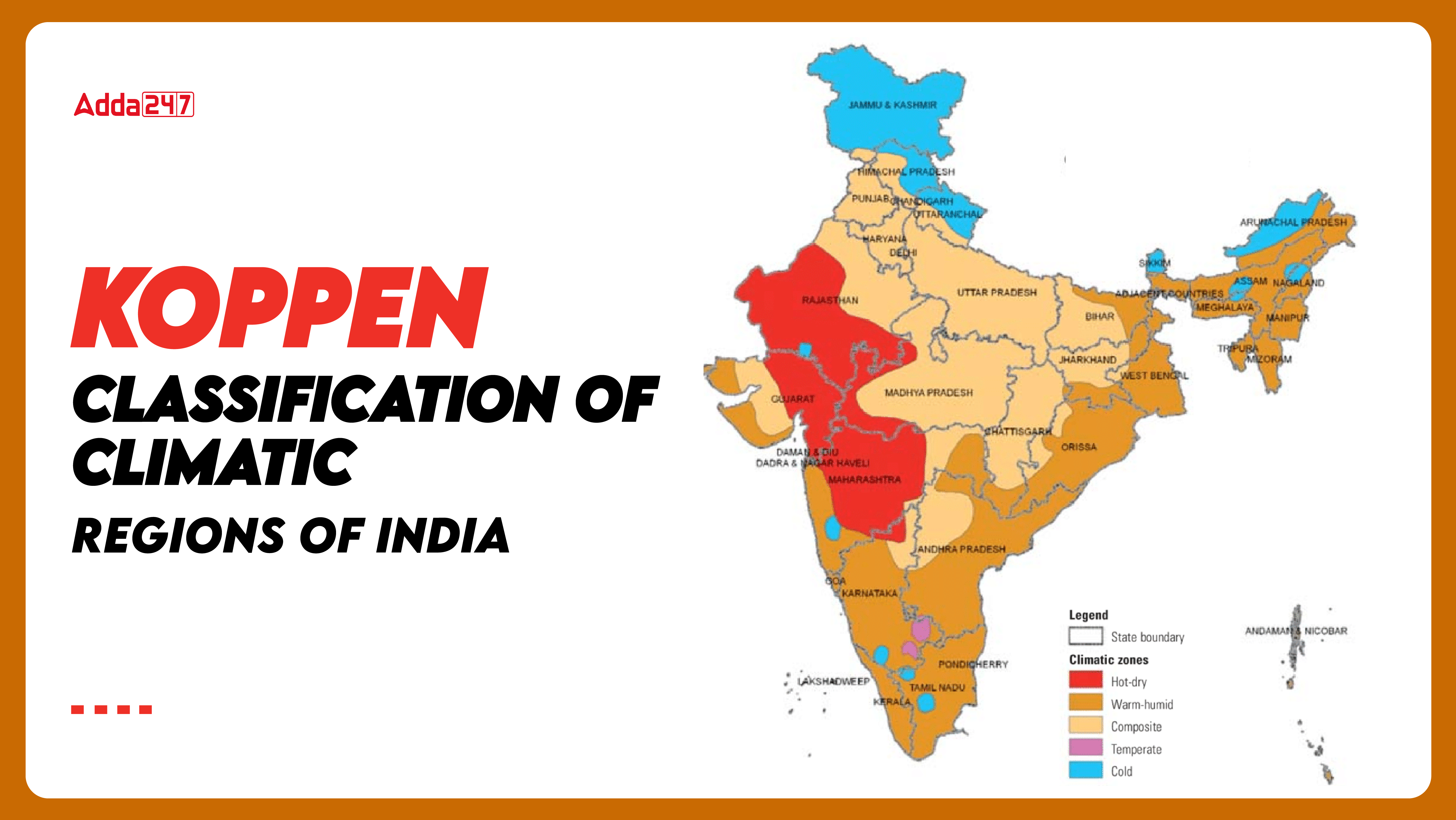Table of Contents
The Koppen climate classification system, developed by German climatologist Vladimir Köppen, is an important and comprehensive tool for classifying and understanding climates. Koppen first presented his classification of world climates in 1918 and fully in 1936. Koppen climate classification system is highly significant on a global scale and in understanding Indian climate. In the Koppen climate classification system, climates are classified based on different climatic zones, allowing an accurate description of the climatic characteristics of each region. The Koppen climate classification system is based on temperature and rainfall data, which provides a clear picture of the climate of any region.
Koppen Climate Classification
The Koppen climate classification was first developed in the late 19th century by German botanist and climatologist Wladimir Köppen. The Köppen climate classification is a widely adopted system used to classify climates worldwide. Köppen and other scientists devised a method for defining climate zones based on these elements. This system studied vegetation, temperature, and precipitation data to designate climate zones. This theory has been revised several times since its development. The classification is divided into five primary climate types, each with several subtypes. The Koppen climate classification is named by capital letters A, B, C, D and E and its subtypes are represented by f, m, w and s.
A- Tropical Humid Climate
Tropical humid climate is divided into three types. First, tropical humid (Af), in which there is no dry season throughout the year and the area is always humid. Second, tropical monsoon (Am), where most of the rainfall occurs in summer and winter is dry. Third, tropical wet and dry (Aw), in which the wet season is short and the dry season is long and extremely dry.
- Tropical humid (Af): There is no dry season throughout the year, due to which the area is always humid.
- Tropical monsoon (Am): In this climate, most of the rainfall occurs in summer, while winter remains dry.
- Tropical wet and dry (Aw): In this type of climate, the wet season is short and the dry season is long and extremely dry.
B- Dry Climates
Dry and semi-arid conditions are found in this class of climate. Generally, only plants that tolerate dry weather are found here, because vegetation is very less. Dry climate is divided into four types. First, subtropical steppe (BSh), second, subtropical desert (BWh), third, mid-latitude steppe (BSk), and fourth, mid-latitude desert (BWk).
- Subtropical steppe (BSh)
- Subtropical desert (BWh)
- Mid-latitude steppe (BSk)
- Mid-latitude desert (BWk)
C- Humid Temperate Zone
Humid temperate climate have hot and dry summers and mild and wet winters. Humid subtropical climates have hot and humid summers and mild winters with frequent rainfall. Oceanic climates have mild temperatures year-round, high humidity and frequent rainfall. The humid temperate climate is classified into four types. First, humid subtropical (Cwa), where there is dry weather in winter and hot weather in summer. Second, Mediterranean (Cs), which is characterized by hot and dry summers and mild and rainy winters. Third, humid subtropical (Cfa), where there is absence of dry season and mild winter. Fourth, marine west coast climate (Cfb), in which there is rainfall throughout the year, but more in winter.
- Humid subtropical climate (Cwa) – Characterised by dry winters and hot summers.
- Mediterranean climate (Cs) – This climate is characterised by hot and dry summers and mild and rainy winters.
- Humid subtropical climate (Cfa) – Characterised by absence of dry season and mild winters.
- Marine west coast climate (Cfb) – Rainfall occurs throughout the year, but more rainfall occurs in winters.
D- Cold Snow Forest
The cold snow-forest climate, also known as the cold boreal forest climate, is characterized by an average temperature of 3°C during the coldest month and an average of 10°C during the summer months. The summer season is relatively short. This climate can be divided into two types: Df, which features a humid winter with a cold environment and a very short frost-free season, and Dw, which features a dry winter with a cold climate, where temperatures are lower in summer and extremely low in winter towards the poles.
E- Polar Climates
The polar climate is classified into two types. The first type is the tundra climate (ET), characterized by a region of permanent frost where the subsoil remains permanently frozen. The second type is the ice cap climate (EF), where the temperature remains below freezing even during the summer months. In this region, precipitation occurs in minimal amounts.
- The tundra climate (ET)- It is characterised by a zone of permanent snow cover, where the subsoil remains permanently frozen
- Ice cap climate (EF)- The temperature here remains below zero even during the summer months. The rainfall in this area is minimal.
Also read- Climatic Regions of India
Subtypes of Koppen Climate Classification
The Koppen climate classification system classifies the world’s climates based on average temperature and precipitation. Earlier we explained the main Koppen climate classification system. Below is the information about the Koppen climate classification subtypes:
- H: Hot Climate – Regions that experience high temperatures year-round, typically found near the equator.
- K: Cold Climate – Areas that have cold temperatures most of the year, often found in polar regions.
- a: Hot Summer – Places with very warm to hot summers, with temperatures often reaching high levels during the summer months.
- b: Warm Summer – Locations with mild to warm summers, but not as hot as those in the “Hot Summer” category.
- C: Cool Summer – Areas where summers are cooler and more moderate in temperature.
- d: Very Cold Winter – Regions that experience extremely cold winters, often with temperatures dropping significantly below freezing.
Koppen Climate Classification Chart
The Koppen climate classification system organizes different climates and climate types into major categories, represented by capital letters of the English alphabet. Additionally, subtypes within these major categories are represented using lowercase letters. This systematic approach allows for a detailed and easy-to-understand representation of global climate.
Types
| Code | Name | Features |
| A | Tropical humid climate | Lowest Tm > 18 °C |
| B | Dry climate | Dry boundary (boundary toward forests) is: for the precipitation period in winter: Rg < 2Tg for fuzzy precipitation: Rg < 2Tg + 14 for the precipitation period in summer: Rg < 2Tg + 28 |
| C | Moderately warm climate | The lowest Tm is between 18 °C and -3 °C |
| D | Moderately cold climate | Highest Tm > 10 °C, and the lowest Tm < -3 °C |
| E | Cold climate | Highest Tm < 10 °C |
Subtype
| Subtype | Name | Features |
| h | Hot climate | Tg > 18 °C |
| k | Cold climate | Tg < 18 °C, and the highest Tm > 18 °C |
| a | Hot summer | Highest Tm > 22 °C |
| b | Warm summer | Highest Tm < 22 °C, and least 4 Tm > 10 °C |
| c | Cool summer | Less than 4 Tm > 10 °C, and the lowest Tm > -38 °C |
| d | Very cold winter | Lowest Tm < -38 °C |
Koppen Climate Classification India Map
The climate of India is of the tropical monsoon type, which keeps changing throughout the year. This climate is divided into five main zones: tropical, arid, semi-arid, temperate, and alpine. When classifying Indian climate zones, most geographers give more importance to rainfall and high temperatures rather than temperature, because changes in rainfall are more pronounced than in temperature.
The arid and semi-arid zones located in parts of Rajasthan and Gujarat have low rainfall and hot summers, leading to desert conditions. On the other hand, the alpine zone located in the Himalayan region has cold temperatures and heavy snowfall.
Temperature and rainfall are two important elements in climate classification that are considered decisive in all schemes. Candidates can understand the climate classification of India with the help of the map given below.

| Related article | |
| Mechanism of Indian Monsoon | Climatic Regions of India |
| Floods | Tropical cyclones |



 TSPSC Group 1 Question Paper 2024, Downl...
TSPSC Group 1 Question Paper 2024, Downl...
 TSPSC Group 1 Answer key 2024 Out, Downl...
TSPSC Group 1 Answer key 2024 Out, Downl...
 UPSC Prelims 2024 Question Paper, Downlo...
UPSC Prelims 2024 Question Paper, Downlo...
